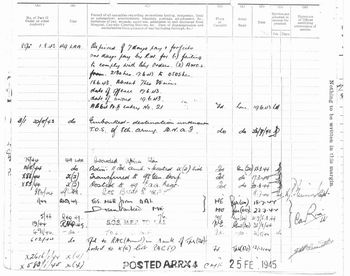
Photo shows: Page from my Army Records showing dates
On the 9th of March, 1943 I was stationed in Hove, Sussex.
My unit, at that time, was the 112th Light Anti-Aircraft Regiment and its 40 mm Bofor Guns were providing defence against Luftwaffe incursions into England via the English Channel.
As part of our air-cover the guns were spread out along the Hove promenade between HMS King Alfred (a Naval Officer’s Training Establishment) and the nearby coastal town of Portslade.
On this particular day I was off duty as a wireless operator and was sunning myself next to one of the guns that was sited on what used to be the kids paddling pool in Hove.
Without any prior warning whatsoever, 'something' came hurtling along the front, travelling from my left to my right, firing its machine guns as it swept along the promenade.
I estimated its height as being no more than two hundred feet directly above me.
The Bofor gun crew had no chance at all to ‘lay on’ to their target but fired ineffectually at the rapidly disappearing Jerry fighter plane.
Everyone, including myself, thought it exceedingly funny (we were much younger in those days) and for the rest of the day we were bragging to all and sundry about how we had scared the living daylights out of the raider.
This then was my vivid memory of that particular attack and (as my wartime diaries of 1942 and 1943 had gone missing over the years) the event was un-recorded but filed away purely in my mind. I also had no idea whatsoever what type of plane had attacked us on that occasion.
That was the situation until a few days ago when I had occasion to send an e-mail to my good friend Peter Ghiringhelli and mentioned this air attack.
To my immense surprise he told me that in fact there were many such low level attacks and all were well documented: locations, dates, etc. and that the raids were known as the 'Tip and Run' campaign of 1942-43.
He went on to say: The Jagers used the Focke-Wulf 190 and were very effective. The best book I know on this is "Luftwaffe Fighter-Bombers over Britain - The Tip and Run Campaign, 1942-43" by Chriss Gross, with Peter Cornwell and Bernd Rauchbach.The fighters concentrated mainly on the south coast and would fly over the channel at top speed at 100 to 500 feet under the radar screen. The tactic was to drop the single bomb on a designated target and then to strafe targets of opportunity and pull out fast. It was highly dangerous and required great skill. All attacks are fully documented in the book.
A subsequent e-mail from Peter confirmed that a Focke-Wulf 190 of 10/Jg 2 strafed Hove at 4.50 PM on 9 March 1943, coming in from Worthing along the coast and that the plane I had seen in action was from a crack fighter unit, a Focke-Wulf 190 from 10(Jabo)/Jadgeschwader 2 'Richtoven' (i.e., 10 (Fighterbomber)/Fighter Group/Squadron No. 2 'Richtoven'), their insignia was a cartoon of a red fox holding a broken ship in its jaws. They were stationed at Caen-Carpiquet.
It has taken sixty-two years for this last piece of a jigsaw puzzle to be fitted into place.
Thank you Peter
No comments:
Post a Comment